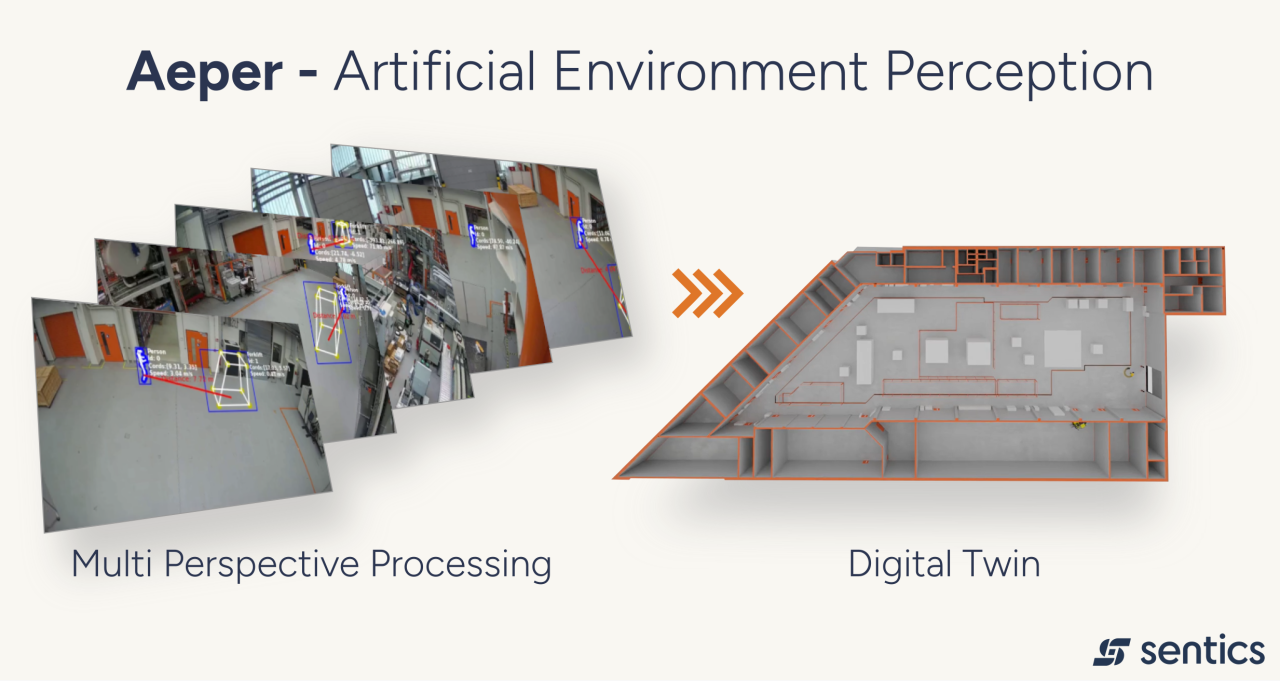Wir erwecken jede industrielle Umgebung zum Leben. – Das ist unsere Vision, wenn wir über unsere Technologie sprechen. Was steckt dahinter?
Einer der wichtigsten Aspekte des Lebens und Überlebens ist unsere Fähigkeit, unsere Umwelt mit unseren Sinnen wahrzunehmen. Vor allem das Sehen ist unser wichtigster Sinn. Technisch gesehen ist das Auge der einzige Breitbandkanal, über den Informationen aus der Außenwelt unseren natürlichen Computer – das Gehirn – erreichen. Die Verarbeitung dieser Informationen ermöglicht es uns, unsere Umgebung wahrzunehmen, Situationen im Zusammenhang zu verstehen und gezielte Handlungen auszuführen.
Unsere Wahrnehmung ermöglicht nicht nur unser tägliches Überleben in einer unvorhersehbaren Welt, sondern bildet auch die Grundlage für einen weiteren wesentlichen Aspekt des Lebens: das kontinuierliche Erlernen neuer Fähigkeiten. Beim Lernen versuchen wir, Handlungen auszuführen, um bestimmte Ziele zu erreichen. Durch Wahrnehmung bewerten wir, ob das Ergebnis mit dem gewünschten Ziel übereinstimmt. Indem wir die Ergebnisse kontinuierlich mit dem Ziel vergleichen, passen wir unsere Handlungen an, verbessern unsere Fähigkeiten und erwerben neue Fähigkeiten.
Bei der Entwicklung der Sentics-Technologie haben wir uns von der Natur inspirieren lassen. Die Idee ist, industrielle Umgebungen mit Wahrnehmung zu versehen und sie so zum Leben zu erwecken, wie es unsere Vision nahelegt. Visuelle Informationen werden von Kameras erfasst.
Im Gegensatz zum Menschen, der seine unmittelbare Umgebung aus der Ich-Perspektive wahrnimmt, muss eine Umgebung gleichmäßig über einen großen Bereich wahrgenommen werden. Um dies zu erreichen, werden mehrere Kameras strategisch in der gesamten Infrastruktur platziert, um eine redundante visuelle Abdeckung der gesamten industriellen Umgebung zu gewährleisten. Diese Kameraströme werden dann in Echtzeit von einem zentralen Server verarbeitet, ähnlich wie das Gehirn sensorische Eingaben verarbeitet. Bildverarbeitungs- und KI-Modelle identifizieren und lokalisieren Objekte – wie Menschen, Fahrzeuge, Maschinen und Anlagen – in der Umgebung.
Der daraus resultierende digitale Zwilling dient als Grundlage für das Verständnis des Prozesskontextes und die Ableitung verwertbarer Erkenntnisse mithilfe weiterer KI-Modelle und regelbasierter Algorithmen. Dieser Prozess ähnelt der Art und Weise, wie ein Mensch Situationen auf der Grundlage von erlerntem Wissen und Erfahrungen vorhersieht.
Nach dem Vorbild der Natur verleiht Sentics industriellen Umgebungen eine künstliche Wahrnehmung, die es ermöglicht, Situationen in Echtzeit zu antizipieren und autonome Entscheidungen zu treffen. Daher auch der Markenname, den wir für unsere Technologie eingeführt haben: Aeper – Künstliche Umweltwahrnehmung.
Die wirtschaftlichen und sozialen Potenziale sind hier enorm. Durch frühzeitiges Erkennen von Unfallrisiken und aktives Eingreifen (z.B. Abbremsen von Fahrzeugen zur Vermeidung von Kollisionen mit Menschen) können die tausenden von Unfällen in der Industrie vermieden werden – ein wichtiger Schritt in Richtung Mission Zero! Ein weiteres Beispiel ist der effiziente Betrieb von autonomen Transportfahrzeugen. Durch umfassende Informationen über den Zustand von Fahrbereichen kann der Flottenbetrieb optimiert oder in den meisten Fällen überhaupt erst effizient eingeführt werden. Sentics ist das erste Unternehmen, das Sicherheits- und Effizienzprodukte auf Basis von Aeper kommerziell anbietet.
Darüber hinaus demonstrieren einige große Technologieunternehmen mit ihren eigenen Entwicklungen die bedeutenden transformativen Potenziale der Aeper-Technologie.
Unser Partner NVIDIA zeigt in einem Blogbeitrag eine virtuelle Simulation, die den Betrieb von autonomen Fahrzeugen in einer Logistikumgebung veranschaulicht:
➡️https://blogs.nvidia.com/blog/ai-digital-twins-industrial-automation-demo/
Ein weiteres Beispiel ist der Elektronikhersteller Foxconn, der auf der COMPUTEX seine eigenen Entwicklungen vorstellte:
➡️https://blogs.nvidia.com/blog/computex-metropolis-nim/
Wenn Sie mehr über Sentics, die Aeper-Technologie sowie unsere Produkte und Dienstleistungen erfahren möchten, können Sie uns gerne kontaktieren.
Wir freuen uns auf den Dialog.
Sebastian Bienia (Founder & CTO)


